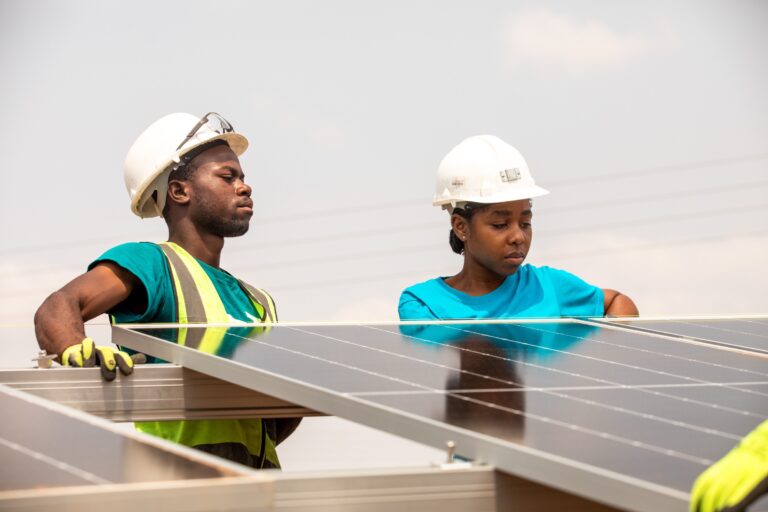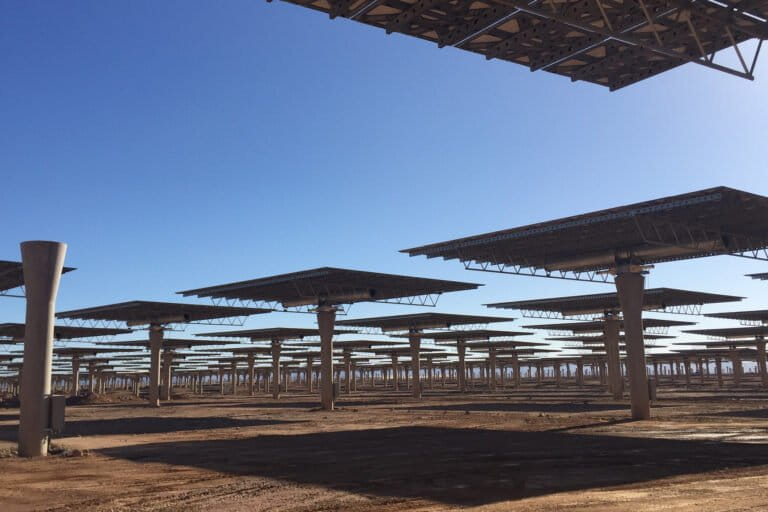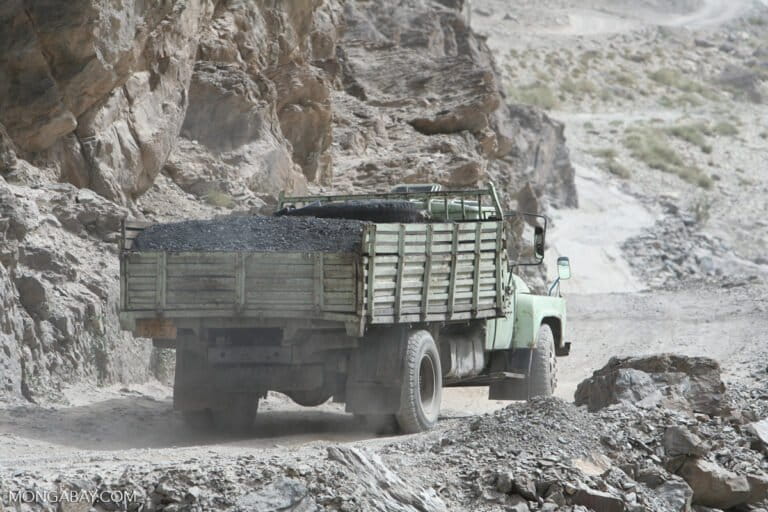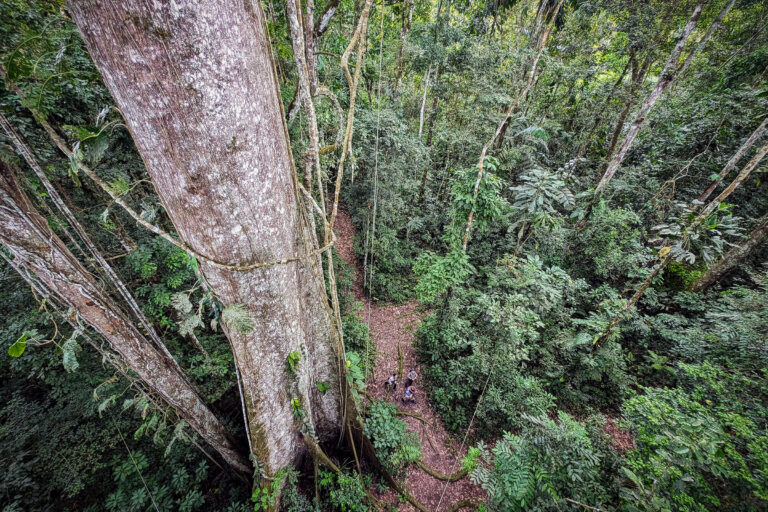Is the oil-palm industry using global warming to mislead the public?
Is the oil-palm industry using global warming to mislead the public?
Rhett A Butler, mongabay.com
November 23, 2007
This is the pre-edited version of an editorial that appeared November 23, 2007 in THE JAKARTA POST. The final piece was titled
Is the palm oil industry misleading the public?.
Members of the Indonesian Palm Oil Commission are distributing materials that misrepresent the carbon balance of oil-palm plantations, according to accounts from people who have seen presentations by commission members. These officials are apparently arguing that oil-palm plantations store and sequester many times the amount of CO2 as natural forests, and therefore that converting forests for plantations is the best way to fight climate change. In making such claims, these Indonesian representatives evidently are ignoring data that show the opposite, putting the credibility of the oil-palm industry at risk, and undermining efforts to slow deforestation and rein in greenhouse gas emissions.
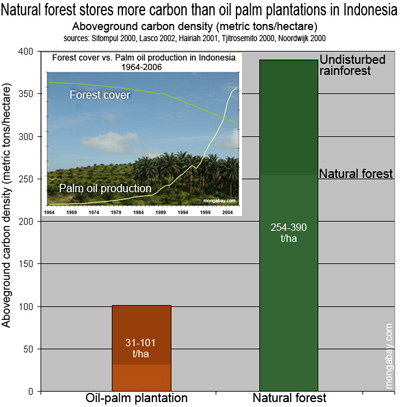
Carbon storage of oil palm plantations versus natural forests, based on various sources. |
A pamphlet distributed last week by the Indonesian Palm Oil Commission (IPOC) states: “Compared to tropical forest, oil-palm plantations possesses [sic] several environmental advantages, it consumes more carbon dioxide (CO2) and releases more oxygen (O2) than tropical forest, which is beneficial to the environment.” The pamphlet cites figures from “Environmental Characteristics of Oil Palm Plantations” (Henson 1999) that show oil-palm plantations apparently bettering natural forest in short-term carbon fixation rates. But the figures ignore overall carbon storage.
Few serious scientists would support the claim that oil-palm plantations store more carbon than natural tropical forests. In fact, several recent studies show that oil-palm plantations, when established in place of peat lands and natural forests, produce more greenhouse gas emissions relative to natural forests. If the use of fertilizer and emissions from processing are factored in, the climate impact of converting natural forests for oil palm is even greater.
Carbon sequestration rates versus carbon storage
As is the case with any plant, oil-palm trees do sequester carbon as they grow—carbon is a basic building block of plant tissue. Nevertheless, the process of clearing forest in order to establish a plantation releases more carbon than will be sequestered by the growing oil palms. So while a new oil-palm plantation may grow faster—and sequester carbon at a higher annual rate—than a naturally regenerating forest, in the end the oil plantation will still store less carbon (50-90 percent less over 20 years) than the original forest cover. The carbon losses are even greater when the plantation is established on peat lands, which store vast amounts of carbon but release it as they are drained. (Upon exposure to air, peat rapidly oxidizes, decomposes, and releases carbon dioxide.)
“The emission from forest conversion clearly exceeds the potential carbon fixation of oil-palm plantings,” Germer and Sauerborn wrote in a 2007 paper published in the journal Environment, Development and Sustainability. “Forest conversion on mineral soils to promote continued oil-palm mono-cropping causes a net release of approximately 650 Mg carbon dioxide equivalents per hectare, while the emission from peat-forest conversion is even higher due to the decomposition of drained peat and the resulting emission of carbon oxide and nitrous oxide.”
Germer and Sauerborn continue: “The conversion of one hectare of forest on peat releases over 1,300 Mg carbon dioxide equivalents during the first 25-year cycle of oil-palm growth. Depending on the peat depth, continuous decomposition augments the emission with each additional cycle at a magnitude of 800 Mg carbon dioxide equivalents per hectare.”
Meine van Noordwijk of the World Agroforestry Center (ICRAF) says that industry claims of carbon superiority for a plantation fall short when one looks at the big picture.
“This is the classical debate on flows versus stocks, of plant physiology versus systems ecology,” Van Noordwijk says. “Currently the pulpwood as well as the oil-palm plantation sector are fighting the battle with claims that they improve the carbon sequestration rates from something like 0.5 t C/ha/yr for maturing forest to values of 3-5 t C/ha/yr for fast-growing plantations—while the world should care about the release of about 250 t C/ha of existing stocks before this increase in rates can be realized. It will take 50-100 years before [carbon storage] equals 250.”
Meanwhile the average life of an oil-palm plantation is less than 30-40 years.
On peat soils, the carbon balance is even less favorable for oil-palm plantations due to emissions from drainage.
Van Noordwijk adds: “The below-ground carbon stocks in peat land can be thousands of t C/ha, and the rates of release may be 30-50 t C /ha/yr—so the above-ground capture by fast-growing pulpwood or oil palm is only 10 percent of the concurrent losses from the peat. It is, indeed, a huge experiment in CO2 fertilization if you grow trees on a peat that has been drained to 80 cm depth as is standard practice in Indonesia.”
Data from Wetlands International, a prominent environmental group that has released a widely cited study on emissions from peat lands degradation and destruction, show that the production of one ton of palm oil on peat land results in carbon dioxide emissions of up to 33 tons. Wetlands International estimates that the 1.5 million hectares of oil palm planted on peat lands in Indonesia contribute 100 tons of carbon dioxide emissions per hectare from draining alone.
Palm oil can be part of the solution
While the data show that oil-palm plantations are no match for natural forests in terms of storing carbon, palm oil can still play a role in efforts to reduce greenhouse gas emissions. Oil palm is one of the world’s most productive oilseeds—on a per-unit-of-area basis, biodiesel yields from oil palm far outstrip those from conventional biofuels like corn, soybeans, sugar beets, rapeseed, and sugar cane. In other words, using oil palm as a source of biodiesel will require the conversion of less land for bioenergy feedstock than other sources, allowing more land to be set aside for other uses, including conservation. The key to maximizing the potential benefits of palm oil is to establish plantations on Indonesia’s tens of millions of hectares of already deforested and abandoned wastelands, while protecting the country’s remaining peat lands and natural forests for biodiversity, carbon storage, and other ecosystem services. To make this a reality, the Indonesian government, palm-oil producers, and palm-oil consumers will need to work together to develop a robust and verifiable supply-chain-tracking mechanism for palm oil or at least ensure that natural forests and peatlands are not converted for production. While it’s understandable that the palm-oil industry would want to portray itself in the best possible light, the industry’s best interests lie in leading these efforts rather than attempting to deceive the public. Such tactics could result in consumer backlash in the future.
THE PUBLISHED JAKARTA POST VERSION
Is the palm oil industry misleading the public?
Rhett Ayers Butler, San Francisco
The Jakarta Post, November 23, 2007
Members of the Indonesian Palm Oil Commission are distributing materials that misrepresent the carbon balance of oil-palm plantations, according to accounts from people who have seen presentations by commission members.
These officials are apparently arguing that oil-palm plantations store many times the amount of CO2 as natural forests, and therefore that converting forests for plantations is the best way to fight climate change.
In making such claims, these Indonesian representatives evidently are ignoring data that show the opposite, putting the credibility of the oil-palm industry at risk, and undermining efforts to slow deforestation and rein in greenhouse gas emissions.
A pamphlet distributed recently by the Indonesian Palm Oil Commission (IPOC) states: “Compared to tropical forest, oil-palm plantations possesses [sic] several environmental advantages, it consumes more carbon dioxide (CO2) and releases more oxygen (O2) than tropical forest, which is beneficial to the environment.”
Few serious scientists would support the claim that oil-palm plantations store more carbon than natural tropical forests. In fact, several recent studies show that oil-palm plantations, when established in place of peat lands and natural forests, produce more greenhouse gas emissions relative to natural forests. If the use of fertilizer and emissions from processing are factored in, the climate impact of converting natural forests for oil palm is even greater.
As is the case with any plant, oil-palm trees do sequester carbon as they grow-carbon is a basic building block of plant tissue. Nevertheless, the process of clearing forest in order to establish a plantation releases more carbon than will be sequestered by the growing oil palms. So while a new oil-palm plantation may grow faster-and sequester carbon at a higher annual rate-than a naturally regenerating forest, in the end the oil plantation will still store less carbon (50-90 percent less over 20 years) than the original forest cover.
The carbon losses are even greater when the plantation is established on peat lands, which store vast amounts of carbon but release it as they are drained. (Upon exposure to air, peat rapidly oxidizes, decomposes, and releases carbon dioxide.)
“The emission from forest conversion clearly exceeds the potential carbon fixation of oil-palm plantings,” Germer and Sauerborn wrote in a 2007 paper published in the journal Environment, Development and Sustainability. “Forest conversion on mineral soils to promote continued oil-palm mono-cropping causes a net release of approximately 650 Mg carbon dioxide equivalents per hectare, while the emission from peat-forest conversion is even higher due to the decomposition of drained peat and the resulting emission of carbon oxide and nitrous oxide.”
Germer and Sauerborn continue: “The conversion of one hectare of forest on peat releases over 1,300 Mg carbon dioxide equivalents during the first 25-year cycle of oil-palm growth. Depending on the peat depth, continuous decomposition augments the emission with each additional cycle at a magnitude of 800 Mg carbon dioxide equivalents per hectare.”
Meine van Noordwijk of the World Agroforestry Center (ICRAF) says that industry claims of carbon superiority for a plantation fall short when one looks at the big picture.
Meanwhile the average life of an oil-palm plantation is less than 30-40 years.
On peat soils, the carbon balance is even less favorable for oil-palm plantations due to emissions from drainage.
Van Noordwijk adds: “The below-ground carbon stocks in peat land can be thousands of t C/ha, and the rates of release may be 30-50 t C /ha/yr-so the above-ground capture by fast-growing pulpwood or oil palm is only 10 percent of the concurrent losses from the peat. It is, indeed, a huge experiment in CO2 fertilization if you grow trees on a peat that has been drained to 80 cm depth as is standard practice in Indonesia.”
Data from Wetlands International, a prominent environmental group that has released a widely cited study on emissions from peat lands degradation and destruction, show that the production of one ton of palm oil on peat land results in carbon dioxide emissions of up to 33 tons. Wetlands International estimates that the 1.5 million hectares of oil palm planted on peat lands in Indonesia contribute 100 tons of carbon dioxide emissions per hectare from draining alone.
While the data show that oil-palm plantations are no match for natural forests in terms of storing carbon, palm oil can still play a role in efforts to reduce greenhouse gas emissions. Oil palm is one of the world’s most productive oilseeds-on a per-unit-of-area basis, biodiesel yields from oil palm far outstrip those from conventional biofuels like corn, soybeans, sugar beets, rapeseed, and sugar cane.
In other words, using oil palm as a source of biodiesel will require the conversion of less land for bioenergy feedstock than other sources, allowing more land to be set aside for other uses, including conservation.
The key to maximizing the potential benefits of palm oil is to establish plantations on Indonesia’s tens of millions of hectares of already deforested and abandoned wastelands, while protecting the country’s remaining peat lands and natural forests for biodiversity, carbon storage, and other ecosystem services.
To make this a reality, the Indonesian government, palm-oil producers, and palm-oil consumers will need to work together to develop a robust and verifiable supply-chain-tracking mechanism for palm oil or at least ensure that natural forests and peatlands are not converted for production.
While it’s understandable that the palm-oil industry would want to portray itself in the best possible light, the industry’s best interests lie in leading these efforts rather than attempting to deceive the public. Such tactics could result in consumer backlash in the future.
The writer is a U.S.-based entrepreneur with a background in economics. He can be reached at mongabay@gmail.com .










